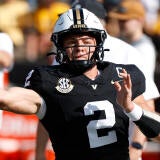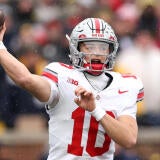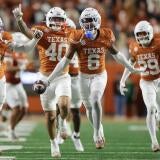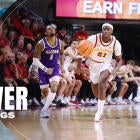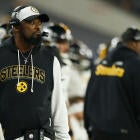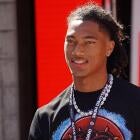Can true freshman Wes Lunt find success replacing Brandon Weeden at Oklahoma State?
If Oklahoma State is to so much as sniff at the success it had in 2011, when it won its first Big 12 Conference championship and knocked off Stanford in the Fiesta Bowl, it must hope a true freshman quarterback can replicate the sort of production the Cowboys got from the 22nd overall pick in the NFL Draft.
If Oklahoma State is to so much as sniff at the success it found in 2011, when it won its first Big 12 Conference championship and knocked off Stanford in the Fiesta Bowl, it must hope a true freshman quarterback can replicate the sort of production the Cowboys got from the 22nd overall pick in the NFL Draft.
Expecting Wes Lunt to be Brandon Weeden right out of the gates is more than a bit unfair. While Lunt did enroll in January to go through spring practice in Stillwater, he's still a wet-behind-the-ears 18-year-old. Weeden, in contrast, is a 28-year-old who knew the ins and outs of major athletics thanks to his time as a professional baseball player.
So perhaps Lunt won’t match Weeden's 2011 numbers: 4,727 passing yards (good enough for second-best in the FBS ranks last year), 72 percent completions and 37 touchdowns.
Or maybe he will.
Besides the obvious talent Lunt must possess to convince Oklahoma State coach Mike Gundy to make him an immediate starter, Lunt will be helped along by the Cowboys' scheme.
Dana Holgorsen installed the Air Raid offense at OSU during his one season as offensive coordinator at the school before becoming head coach at West Virginia, and Todd Monken has continued to operate a highly similar scheme since taking over the same position.
The good news for Lunt (and Cowboys fans) is that, historically, quarterbacks have fared extremely well in their first year operating the Air Raid scheme. The examples cover several of the top quarterbacks of the last 15 years in college football:
- Geno Smith, West Virginia, 2011: 346 of 526 (65.8 percent); 4,385 yards, 31 TDs, 7 INTs
- Brandon Weeden, Oklahoma State, 2010: 258 of 384 (67.2 percent); 3,391 yards, 27 TDs, 10 INTs
- Case Keenum, Houston, 2008: 397 of 589 (67.4 percent); 5,020 yards, 44 TDs, 11 INTs
- Graham Harrell, Texas Tech, 2006: 412 of 616 (66.9 percent); 4,555 yards, 38 TDs, 11 INTs
- Josh Heupel, Oklahoma, 1999: 310 of 500 (62.0 percent); 3,460 yards, 30 TDs, 15 INTs
- Tim Couch, Kentucky, 1997: 363-of-547 (66.4 percent); 3,884 yards, 37 TDs, 19 INTs
While some believe the Air Raid scheme leads to quarterbacks just throwing the ball deep at every opportunity, the completion percentages above -- again, all in their first year operating the scheme -- show that the system allows QBs to find open teammates with relative ease. The ball goes to athletic receivers who then proceed to make plays in space.
Even the way the coaches teach the system is aimed at keeping things easy to understand, which should bode well for Lunt -- as OSU backup Clint Chelf told Berry Tramel of the Oklahoman:
“There's not a whole lot of verbiage, words,” Chelf said. “Some of the things are pretty simple in that aspect. My true freshman year, when Coach Gundy was still calling plays in that (Zac Robinson) offense, I was in way over my head. Compared to that offense, this offense is extremely easy. The playbook is not even close to being as thick as it was. The quarterbacks, hardest part of it, is having the freedom to make all those decisions at the line.”
A thin playbook (Holgorsen, now at WVU, famously doesn’t use a playbook at all) and simple terminology should help ease the learning curve for Lunt -- and future quarterbacks stepping into the Air Raid system for the first time.
Before Oklahoma State fans start to feel too confident about Lunt’s chances in his first season of college football, there should be one additional caveat: none of the above players were true freshmen when they took the reigns of the Air Raid.
But much of the experience those players had before the seasons in question came in very different offenses -- Smith at West Virginia, Heupel at Oklahoma and Couch at Kentucky are three prominent examples.
Perhaps the Cowboys will score fewer points in their first season of the post-Weeden (and Justin Blackmon) era. But the drop-off may not be as significant as some might expect with a true freshman playing quarterback. If Lunt can live up to the results posted by other first-year Air Raid quarterbacks, OSU may finish with another excellent season.
For more up-to-the-minute news and analysis on the Big 12, follow bloggers C.J. Moore and Patrick Southern on Twitter @CBSSportsBig12.

